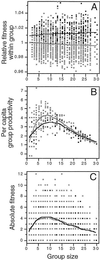Solving the freeloaders paradox: Genetic associations and frequency-dependent selection in the evolution of cooperation among nonrelatives
- PMID: 12381790
- PMCID: PMC137873
- DOI: 10.1073/pnas.212408299
Solving the freeloaders paradox: Genetic associations and frequency-dependent selection in the evolution of cooperation among nonrelatives
Abstract
One of the enduring problems in the study of social evolution has been to understand how cooperation can be maintained in the presence of freeloaders, individuals that take advantage of the more cooperative members of groups they are eager to join. The freeloader problem has been particularly troublesome when groups consist of nonrelatives, and no inclusive fitness benefits accrue to individuals that contribute more heavily to communal activities. These theoretical difficulties, however, are not mirrored by the numerous examples of cooperative or even altruistic behaviors exhibited by groups of nonrelatives in nature (e.g., many human groups, communally nesting bees, multiple queen-founding ants, cellular slime molds, and social bacteria). Using a model in which cooperation and grouping tendencies are modeled as coevolving dynamical variables, I show that the freeloader problem can be addressed when group-size effects on fitness are considered explicitly. I show that freeloaders, whose presence is reflected in the development of linkage disequilibrium between grouping and cooperation, increase in frequency when rare, but are selected against when common due to the reduced productivity of the groups they overburden with their presence. Freeloader frequencies thus periodically rise and fall around an equilibrium shown here to be dynamic. These results highlight the importance of group-level effects in the origin and maintenance of sociality, illustrate the dynamic nature of equilibria when multiple levels of selection are involved, and provide a solution to the freeloaders paradox.
Figures




References
-
- Alexander R. D. (1974) Annu. Rev. Ecol. Syst. 5, 325-383.
-
- Wilson E. O., (1975) Sociobiology: The New Synthesis (Belknap Press of Harvard Univ. Press, Cambridge, MA).
-
- Hamilton W. D. (1964) J. Theor. Biol. 7, 1-16. - PubMed
-
- Hamilton W. D. (1975) in Biosocial Anthropology, ed. Fox, R. (Wiley, New York), pp. 133–155.
-
- Wade M. J. (1980) Science 210, 665-667. - PubMed
Publication types
MeSH terms
LinkOut - more resources
Full Text Sources

